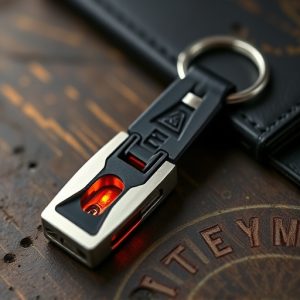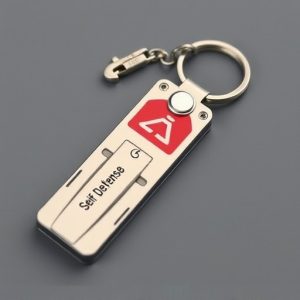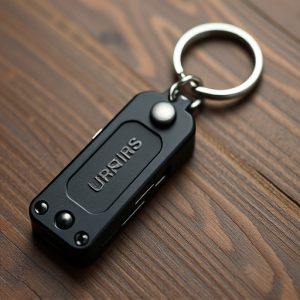Impact Resistant Keychain Weapons: Crafting, Design, Legalities, and Testing
Impact resistant keychains, crafted with high-strength steel or advanced composites, offer users an…….
Impact resistant keychains, crafted with high-strength steel or advanced composites, offer users an extra layer of security through their robust design that absorbs and dissipates force. With a compact size and discreet carry, these keychains are effective personal defense tools, especially in deterring or escaping attackers. Balancing protection and usability, they incorporate materials like stainless steel or titanium for durability and ergonomic designs for quick deployment. Legal status varies globally, with regulations focusing on preventing weapon misuse; users must employ them responsibly within legal boundaries. Testing is crucial to ensure effectiveness and reliability as a self-defense tool.
In today’s world, personal safety is paramount. Enter the impact resistant keychain—a compact, innovative self-defense tool gaining traction. This article explores the multifaceted nature of these keychains, delving into their role as potent weapons, the materials that make them effective, and crucial design considerations for optimal protection. We’ll also dissect legal implications, ethical use, and testing methods, providing a comprehensive guide to understanding impact resistant keychain weapons and their potential as life-saving tools.
- Understanding Impact Resistant Keychains: Their Role as Self-Defense Tools
- Materials Used in Crafting Effective Blunt Force Keychain Weapons
- Design Considerations for Optimal Protection and Usability
- Legal Implications and Ethical Use of Self-Defense Keychains
- Testing and Evaluating the Effectiveness of Your Impact Resistant Keychain
Understanding Impact Resistant Keychains: Their Role as Self-Defense Tools
Impact resistant keychains, a far cry from their mundane counterparts, are emerging as innovative self-defense tools that offer users an extra layer of security. Crafted from robust materials like high-strength steel or advanced composites, these keychains are designed to withstand significant impact and deform energy, turning them into potent weapons in unexpected situations. Their compact size and ease of carry make them a discreet yet effective personal defense option for individuals seeking peace of mind.
When considering an impact resistant keychain as a self-defense tool, the choice of materials plays a pivotal role. Advanced materials not only ensure maximum durability but also allow the keychain to absorb and dissipate force during use, minimizing potential injury to the user. This unique ability makes them ideal for situations where one might need to deter or escape from an attacker, providing a temporary yet crucial window for safety.
Materials Used in Crafting Effective Blunt Force Keychain Weapons
In crafting an effective blunt force keychain weapon, selecting the right materials is paramount. Key factors include durability and impact resistance to ensure the keychain can withstand the forces it may encounter during use. High-quality metals like steel, aluminum, or titanium are popular choices due to their robust nature. These metals offer excellent strength-to-weight ratios, making them ideal for compact, portable self-defense tools. Some advanced models might incorporate specialized alloys designed specifically for high-impact applications, further enhancing the keychain’s effectiveness.
Additionally, the design often incorporates impact-absorbing components to reduce recoil and minimize the risk of injury during a strike. Soft, yet resilient materials like rubber or silicone can be strategically placed to cushion the force, while harder metals retain their structural integrity. This combination allows for a powerful yet controlled impact, making such keychains versatile tools for various scenarios without sacrificing portability.
Design Considerations for Optimal Protection and Usability
When designing an impact-resistant keychain weapon, balancing protection and usability is paramount. The materials chosen should offer superior durability and impact resistance to ensure the keychain can withstand sudden, forceful impacts without compromising its structural integrity. High-quality metals like stainless steel or titanium are excellent options due to their strength-to-weight ratio. These materials not only resist dents and scratches but also maintain their edge for effective self-defense.
Additionally, ergonomic design elements are crucial for optimal usability. A well-designed keychain should fit comfortably in the hand, allowing users to grasp it firmly during emergencies. Smooth edges and a non-slip grip surface enhance control, making it easier to deploy quickly when needed. Moreover, thoughtful consideration should be given to the overall size and weight of the keychain, ensuring it is compact enough to carry discreetly while still providing adequate protection.
Legal Implications and Ethical Use of Self-Defense Keychains
The legal landscape surrounding self-defense keychains, particularly those designed with blunt force capabilities, varies significantly across jurisdictions. While many countries and states allow citizens to carry self-defense tools for personal safety, there are stringent regulations in place to prevent misuse. The definition of a “weapon” often plays a pivotal role, with laws classifying impact-resistant keychain weapons based on their potential as a causing harm. Materials used in construction also come under scrutiny; metal keychains with specific designs or features might be subject to stricter controls.
Ethically, the use of such keychains raises important questions about self-defense versus aggression. Users must exercise restraint and consider the consequences of their actions. The blunt force capabilities should only be employed as a last resort when facing an imminent threat. Responsible ownership includes understanding local laws and using the keychain for its intended purpose—self-protection—rather than as a means to inflict excessive or unnecessary harm.
Testing and Evaluating the Effectiveness of Your Impact Resistant Keychain
Testing and evaluating your impact-resistant keychain’s effectiveness is a crucial step to ensure its reliability as a self-defense tool. Start by assessing the keychain’s construction quality; check for sturdy joints, secure fastening mechanisms, and robust materials used in its manufacture. The weapon should be designed with a solid striking surface that can withstand force without deforming or breaking, ensuring it retains its effectiveness during critical situations.
Perform simulated impact tests on various surfaces to gauge the keychain’s performance. Use standard-issue weapons like batons or even specialized impact test equipment for more accurate results. Evaluate how well the keychain absorbs and transfers force, considering factors like material composition and thickness. Remember, an effective impact-resistant keychain should be able to protect against blunt-force trauma without losing its integrity, ensuring your safety in unexpected scenarios.
An impact resistant keychain, crafted with the right materials and thoughtful design, can serve as a powerful self-defense tool. By understanding the legal implications and using it responsibly, individuals can empower themselves in unexpected situations. When selecting your keychain weapon, consider high-quality materials that ensure maximum durability and effectiveness, making it an essential addition to your personal safety arsenal.


